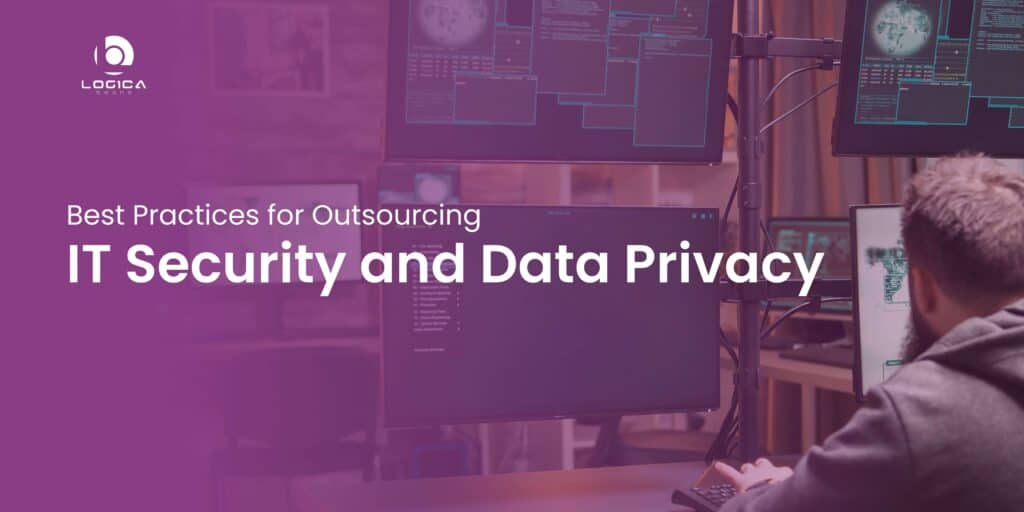Cyber risks and data breaches are more prevalent than ever in today’s environment. As businesses rely more on technology to store and handle sensitive data, it’s becoming increasingly necessary for them to safeguard themselves and their customers against cyber assaults. Businesses can reduce these risks by outsourcing IT security and data privacy. Nonetheless, proper practices must be followed to ensure that outsourcing does not introduce new risks.
In this article, we will look at the best practices for outsourcing IT security and data privacy in the age of cyber threats, giving useful insights for organizations wishing to safeguard their assets and reputation.
IT security and data privacy in today’s digital landscape
IT security and data privacy are critical in today’s digital world. With more sensitive information being kept and sent online, the potential of cyber assaults and data breaches has never been greater. High-profile data breaches have harmed millions of people and cost organizations billions of dollars in damages and lost income in recent years.
Companies and organizations of all sizes must take proactive steps to safeguard their IT infrastructure and data against cyber-attacks. This entails putting in place strong security processes and procedures to protect sensitive information like client data, financial records, and intellectual property. Businesses must also keep current on security risks and developments and change their security plans accordingly.
One of the key challenges in IT security and data privacy is the growing complexity of the digital landscape. As more devices, applications, and services are connected to the internet, the attack surface for cyber criminals continues to expand. This means that companies must take a holistic approach to security, addressing vulnerabilities across their entire IT infrastructure and implementing multiple layers of protection.
Companies must take proactive efforts to preserve their IT infrastructure and sensitive data to protect against cyber-attacks and remain compliant with data privacy rules. This entails putting in place a variety of technological, administrative, and physical safeguards to defend against various forms of cyber threats, as well as developing an incident response strategy in the event of a cyber-attack or data breach. Businesses must also keep current on the newest security threats and trends, as well as take a holistic strategy to security to address vulnerabilities throughout their whole IT infrastructure.
IT security and data privacy are critical for retaining consumer confidence and loyalty, in addition to defending against cyber-attacks and complying with data privacy legislation. Customers expect organizations to preserve their personal information and protect them from cyber dangers in today’s highly competitive business climate. Businesses who do not emphasize IT security and data privacy risk losing clients to competitors that do.
IT security and data privacy are critical for adhering to industry-specific legislation and norms. Several industries, such as healthcare and banking, have their own set of data protection policies and requirements. Businesses in these areas must follow certain norms and standards to avoid legal liability and keep their operating license.
IT security and data privacy are critical issues that companies and organizations must address in today’s digital landscape. By prioritizing IT security and data privacy, companies can protect their valuable data, maintain customer trust and loyalty, ensure business continuity, and comply with industry-specific regulations and standards.
Key challenges involved in outsourcing IT security and data privacy.
Outsourcing IT security and data privacy has grown in popularity in recent years as firms seek to save costs while leveraging the expertise of specialist security providers. Yet, outsourcing these vital services brings with it a number of significant issues that must be addressed in order to achieve a successful outsourcing deal.
The possibility of losing control over sensitive data is one of the most significant concerns of outsourcing IT security and data privacy. Companies must commit sensitive data to a third-party supplier when outsourcing these tasks, which increases the risk of data breaches and illegal access to secret information. As a result, businesses must carefully examine possible outsourcing partners and set explicit contractual provisions that assure data confidentiality and security.
Another issue with outsourcing IT security and data privacy is the possibility of vendor lock-in. Businesses can become reliant on their outsourcing partner for crucial security services, limiting their flexibility and capacity to adapt to changing security requirements. As a result, businesses must have clear exit strategies and contingency plans to guarantee that they can transition to a new outsourcing partner or bring these operations in-house as needed.
Moreover, outsourcing information technology security and data privacy necessitates excellent coordination and communication between the firm and the outsourced provider. Establishing defined roles and duties, exchanging information and insights, and monitoring performance to ensure that the outsourcing partner is satisfying the company’s security and data privacy standards are all part of this.
Outsourcing IT security and data privacy can offer several benefits to businesses, but also comes with several key challenges. To ensure a successful outsourcing arrangement, companies must carefully evaluate potential outsourcing partners, establish clear contractual terms, maintain effective communication and coordination, and ensure compliance with data privacy regulations and standards.
Best practices for outsourcing IT security and data privacy
Outsourcing IT security and data privacy can provide many benefits to businesses, but it also comes with several risks and challenges. Therefore, it is important to follow best practices to ensure a successful outsourcing arrangement. Here are some best practices to follow:
● Identify the key stakeholders in the outsourcing process
It is critical to include all essential stakeholders in the outsourcing process to ensure that everyone understands the goals, needs, and expectations. The IT department will be responsible for administering the outsourced services, while the legal department will be responsible for reviewing and negotiating the contractual conditions. Top management will also be required to give supervision and verify that the outsourcing arrangement matches with the broader aims of the firm.
● Develop a comprehensive outsourcing plan that includes clear objectives, requirements, and expectations
A well-defined outsourcing strategy will offer a clear picture of the scope of the outsourcing relationship and what the outsourced partner is expected to do. This strategy should include a full explanation of the outsourced services, the necessary security and privacy safeguards, SLAs, and performance KPIs.
● Perform a thorough risk assessment to identify potential security and privacy risks
A thorough risk assessment will assist in identifying possible vulnerabilities, threats, and hazards to data security and privacy. This evaluation should take into account the type of data being outsourced, the security posture of the outsourcing partner, and the regulatory environment.
● Perform a thorough risk assessment to identify potential security and privacy risks
SLAs are essential for ensuring that the outsourcing partner adheres to the agreed-upon security and privacy standards. These SLAs should include the performance expectations for the outsourced partner as well as the unique security and privacy needs.
● Establish clear service level agreements (SLAs) that specify the security and privacy requirements and expectations
To provide the greatest protection for your sensitive data, hire a partner with the requisite competence and experience in IT security and data privacy. Potential outsourcing partners should be evaluated based on their experience, reputation, and track record.
● Select a reputable and experienced outsourcing partner with a proven track record in IT security and data privacy
To protect against cyber threats and unauthorized access, it is essential to implement robust security controls such as encryption, access controls, and monitoring systems. These controls should be tailored to the specific needs of the outsourced services and should align with the organization’s overall security and privacy policies.
● Implement robust security controls to protect against cyber threats
To guard against cyber risks and unauthorized access, strong security measures such as encryption, access restrictions, and monitoring systems must be implemented. These controls should be adapted to the unique demands of the outsourced services and should be consistent with the broader security and privacy policies of the company.
● Regularly monitor and evaluate the outsourcing partner’s performance to ensure compliance with SLAs and security requirements
Regular monitoring and evaluation of the outsourcing partner’s performance can help identify any areas of improvement and ensure that the outsourcing partner is meeting the agreed-upon security and privacy requirements.
● Conduct regular audits and assessments to identify vulnerabilities and address any issues promptly
Frequent audits and assessments can aid in the identification of possible vulnerabilities and the resolution of any security concerns before they become a problem. These audits should be performed on a regular basis and should include the participation of an independent third-party auditor.
● Establish clear communication channels between the outsourcing partner and internal IT teams
Effective lines of communication between the outsourcing partner and the internal IT teams help guarantee that everyone is aware of the security and privacy needs and expectations. This communication should be continual, with frequent meetings and reports on how the outsourced services are performing.
Outsourcing IT security and data privacy requires a comprehensive and well-defined approach that involves all relevant stakeholders, robust security controls, and regular monitoring and evaluation. By following these best practices, businesses can ensure a successful outsourcing arrangement that prioritizes IT security and data privacy.
Challenges and risks of outsourcing IT security and data privacy
Outsourcing IT security and data privacy can provide many benefits to businesses, such as cost savings, improved efficiency, and access to specialized expertise. However, outsourcing also involves significant risks and challenges that must be addressed through effective risk management strategies.
In this section, we will discuss some of the potential risks and challenges associated with outsourcing IT security and data privacy.
● Data breaches
Businesses must verify that proper security measures are in place to avoid data breaches when entrusting sensitive data to outsourcing partners. If a data breach happens, it can cause considerable financial and reputational harm, as well as legal ramifications. Companies must ensure that their outsourcing partners have effective security processes in place and that possible risks are monitored on a regular basis.
● Loss of control
Outsourcing IT security and data privacy tasks might result in a loss of data management and security control. When companies outsource these tasks, they must maintain some level of monitoring and control. Companies must set explicit SLAs outlining their data handling and security expectations and standards. Furthermore, organizations must maintain good communication lines with their outsourcing partners to stay informed and updated on any changes or upgrades.
● Regulatory compliance issue
Outsourcing IT security and data privacy might cause compliance challenges because organizations must still adhere to numerous data protection and privacy standards. Failing to comply with these requirements can result in severe fines and legal consequences. Companies must verify that their outsourcing partners have the appropriate skills and resources to comply with these rules.
● Lack of transparency
Outsourcing IT security and data privacy might result in a lack of transparency since organizations can not have direct access to the operations and systems of their outsourced partners. This lack of transparency can make it difficult for organizations to monitor and evaluate the performance of their outsourcing partners. To overcome this issue, organizations should create open lines of communication with their outsourcing partners, as well as periodically monitor and assess their performance in relation to agreed-upon SLAs and security criteria.
● Cultural differences
Working with an offshore partner on IT security and data privacy can entail working with a team from a foreign nation, with a different culture and language. This can cause communication and coordination issues, leading to misunderstandings and blunders. To promote efficient communication and collaboration, businesses should ensure that their outsourcing partner has proper language competency and cultural understanding. They should also develop a clear communication strategy and instruct their outsourced partner on their business culture and values.
It is essential to address all these risks and challenges through effective risk management strategies. Some of the key strategies that businesses can include are:
● Conducting a thorough risk assessment
Businesses should undertake a full risk assessment before outsourcing IT security and data privacy to identify possible risks and weaknesses. This evaluation should consider the security risks connected with outsourcing, such as the security standards of the outsourcing partner, the sensitivity of the data being exchanged, and the possible effect of a data breach.
● Establishing clear SLAs
Businesses should develop explicit SLAs that outline the security and privacy criteria and expectations for their outsourcing partner to guarantee that security and privacy standards are satisfied. Data encryption, data access controls, data backups, and incident response protocols should all be included in SLAs.
● Selecting a reputable outsourcing partner
Businesses should select an outsourcing partner that has a proven track record in IT security and data privacy. This partner should have established security protocols, robust data protection measures, and experienced staff with specialized security skills.
● Implementing robust security controls
Businesses should implement robust security controls to protect against cyber threats. This can include using firewalls, intrusion detection and prevention systems, antivirus and antimalware software, and other security tools to protect against cyber threats.
● Regularly monitoring and evaluating performance
Businesses should regularly monitor and evaluate their outsourcing partner’s performance to ensure compliance with SLAs and security requirements. This monitoring can include regular audits and assessments to identify vulnerabilities and address any issues promptly. Additionally, businesses should establish clear communication channels with their outsourcing partner to ensure effective communication and collaboration.
While outsourcing IT security and data privacy entails considerable risks, it can also open new avenues for increased security and privacy. Outsourcing partners can offer particular experience and resources that can help a firm improve its security posture. Businesses can meet their IT security and data privacy goals while lowering costs and boosting productivity by carefully controlling these risks and embracing the benefits of outsourcing.
Conclusion
As a business owner or manager, you must appreciate the crucial role that information technology security and data privacy play in the success of your operations. Outsourcing IT security and data privacy operations can be a cost-effective approach to acquire specialist knowledge, but it also comes with substantial risks and obstacles. You can reduce these risks and maintain the security and privacy of your sensitive data by following best practices and taking a proactive approach to outsourcing.
Remember to do a complete risk assessment, develop explicit service level agreements, choose a trustworthy outsourcing partner, install strong security measures, and monitor and evaluate the outsourcing partner’s performance on a regular basis. By doing so, you can get the benefits of outsourcing while maintaining security and confidentiality.










